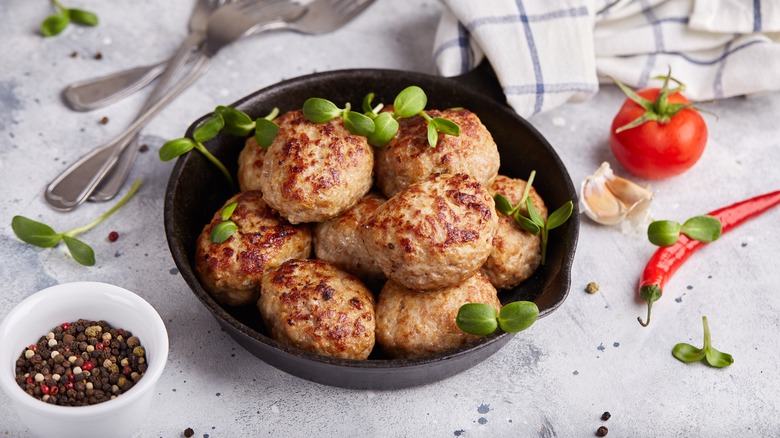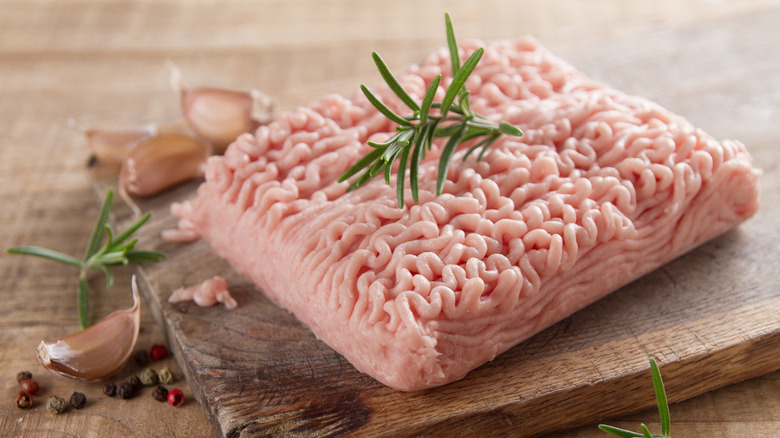Which Bird Parts Are Actually Used For Ground Turkey Meat?
Ground turkey is affordable and versatile, but it also raises the question: What exactly is it made of? With whole cuts like legs, wings, and breasts, you can clearly identify what part of the animal you're about to put in your mouth. With the shapeless mass that is ground meat, you can't be so sure. Products made from ground meats have been the subject of much scrutiny in recent years. People speak in grisly tones about what processed meats are made of. They retch at the mention of chicken nuggets. It's true that some of these items have been found to include ground bones, feet, and blood. Many Americans have a negative gut reaction to these words, and even though all of those things are actually fine to consume, it's unsettling to feel like food manufacturers are hiding something from you. Thankfully, store-bought ground turkey isn't so mysterious.
Ground turkey is typically made from thighs and drumsticks. You can sometimes find ground turkey breast, usually labeled as such, but this is more expensive. You shouldn't worry about manufacturers hiding any bones or internal organs in there because it's not legal to do so. USDA regulations state, "Ground poultry can contain only muscle meat and skin with attached fat in natural proportions." Additional fillers, such as giblets, are not permitted. Some people might still be put off by the idea that ground meat is made from the cheapest cuts, but when it comes to poultry, expensive doesn't equal better.
Dark meat in ground turkey is a great thing
White poultry meat is more expensive than dark meat, but the reasoning behind this is arbitrary. Americans overvalue white meat based on the idea that leaner meats are automatically healthier than fattier meats. This ideology came with the anti-fat fervor that swept the U.S. in the second half of the 20th century. Fat makes you gain weight, so the reasoning went. However, contemporary studies have shown that the reality is far more complex.
Most of the fat in turkey is unsaturated, which is actually beneficial. However, the addition of skin to ground turkey blends does raise their saturated fat content as compared to skinless cuts. Many have also touted the high protein content of white meat, but in actuality, it's barely higher than dark meat. White meat is rich in vitamins and minerals, but so is dark meat. Their nutritional differences have been widely misunderstood.
You'd be hard-pressed to find any professional chef that prefers white meat to dark meat. Dark meat is juicy and tender while having a far richer flavor. White meat is less flavorful, and its near-total lack of fat leads it to dry out quickly.
Choosing the right ground turkey
There's a lot of variety in ground turkey, and that has a huge impact on your cooking. The biggest thing to consider when choosing ground meats of any kind is their fat content. The USDA states that ground turkey must contain fat in natural proportions, so you can't add a whole bunch of extra fat that you wouldn't actually find in the bird. Ground turkey tops out at 15% fat. In this case, it will be labeled 85/15. The most common ratio in grocery stores is 93/7 ratio, but ground turkey can get as lean as 99/1.
When considering the fat content of ground turkey, you must think about what you're using it for. The most common complaint about turkey burgers is that they are dry and bland, but by using a higher fat ratio, such as 85/15 or 90/10, along with a well-seasoned turkey burger recipe, you can easily eliminate this issue.
Lastly, if you're still worried about the content of ground turkey, you can choose to grind it yourself. The saturated fat in turkey skin will surely be a point of concern for some, which is why personally grinding skinless cuts can be a great choice. By grinding your own meat, you can have total control over every element.


